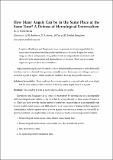Files in this item
How many angels can be in the same place at the same time? A defense of mereological universalism
Item metadata
| dc.contributor.author | Cotnoir, Aaron | |
| dc.date.accessioned | 2018-09-30T23:49:56Z | |
| dc.date.available | 2018-09-30T23:49:56Z | |
| dc.date.issued | 2016-10 | |
| dc.identifier | 183719035 | |
| dc.identifier | cf742362-e39f-4d97-95fc-dac47c854b04 | |
| dc.identifier | 000386946000002 | |
| dc.identifier | 000386946000002 | |
| dc.identifier | 84992588805 | |
| dc.identifier.citation | Cotnoir , A 2016 , ' How many angels can be in the same place at the same time? A defense of mereological universalism ' , Mind , vol. 125 , no. 500 , pp. 959-965 . https://doi.org/10.1093/mind/fzv158 | en |
| dc.identifier.issn | 0026-4423 | |
| dc.identifier.other | ORCID: /0000-0003-4528-7570/work/65702608 | |
| dc.identifier.uri | https://hdl.handle.net/10023/16113 | |
| dc.description.abstract | I reply to Hawthorne and Uzquiano's (2011) arguments for the incompatibility between mereological universalism and plenitudinous co-location. I argue that a mereology in which antisymmetry for parthood fails is independently motivated, and allows for both universalism and plenitudinous co-location. There can be as many angels in a place as there are cardinalities. | |
| dc.format.extent | 7 | |
| dc.format.extent | 60978 | |
| dc.language.iso | eng | |
| dc.relation.ispartof | Mind | en |
| dc.subject | B Philosophy (General) | en |
| dc.subject.lcc | B1 | en |
| dc.title | How many angels can be in the same place at the same time? A defense of mereological universalism | en |
| dc.type | Journal article | en |
| dc.contributor.institution | University of St Andrews. Philosophy | en |
| dc.identifier.doi | https://doi.org/10.1093/mind/fzv158 | |
| dc.description.status | Peer reviewed | en |
| dc.date.embargoedUntil | 2018-10-01 |
This item appears in the following Collection(s)
Items in the St Andrews Research Repository are protected by copyright, with all rights reserved, unless otherwise indicated.

